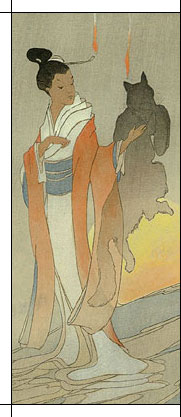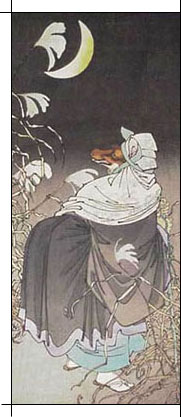
|
+ |
|
|
+ |
|
|
+ |
|
|
Western |
+ |
|
Vulpines |
+ |
|
+ |
|
|
+ |
|
|
That's not what they meant... |
+ |
|
Graves, roofs, and your own living room |
+ |
|
+ |
|
|
Where next? |
+ |
|
|
|


Fox spirits arrived in Japan in the late seventh century. Although the first signs of their arrival were modest, they flourished, and soon were one of the staples of Japanese folklore. They even did what their Chinese sisters failed to do: They were accepted as part of the official religion. Today, statues of the rice-god Inari's fox servants are commonplace in Japan, and Inari himself is popularly believed to be a fox. In the voyage across the ocean, Japanese foxes also lost a few of the functions which Chinese foxes fulfill. For example, kitsune are not poltergeists, and they rarely live side-by-side with humans in human dwellings. Japanese men do not have kitsune friends whom they visit at home for drinking parties and gossip. The human world and the kitsune world do not intermingle as easily as they do in China; kitsune are the outsider, whether as kami or as demon, and Japanese stories do not reveal or explore their world. Stories and Plays • Worship • Resources Japanese Terminology Kitsune: Fox. The standard term for a spirit fox. Myobu: Celestial fox. One of the foxes which is sworn to Inari's service. Nogitsune: Wild fox (lit., "field fox"). Nogitsune are not sworn to Inari's service, and are therefore capable of evil. Youko: Spirit fox. An uncommon term. Books and Theses Bathgate, Michael R. The Shapeshifter Fox: The Imagery of Transformation and the Transformation of Imagery in Japanese Religion and Folklore. Chicago: The University of Chicago, June 2001. Doctoral thesis. Blacker, Carmen. The Catalpa Bow: A Study of Japanese Shamanistic Practices. Routledge Curzon, 1999. [find it] A thorough description of Japanese shamanism that includes an entire chapter on magical animals, including kitsune. Davis, Winston. Dojo: Magic and Exorcism in Modern Japan. Stanford: Stanford University Press, 1980. [find it] A study of the Sukyo Mahikari sect, a religion that believes in possession by spirit animals and the dead. The author describes several cases of fox possession and exorcism. Giles, Herbert A. Strange Stories from a Chinese Studio. Shanghai: Kelly & Walsh, 1926. [find it] Kawai Hayao. The Japanese Psyche: Major Motifs in the Fairy Tales of Japan. Dallas: Spring Publications, 1988. [find it] Morishige, Yumi. Cultural Construction of Foxes. Thesis (M.A.), Cornell University, 1994. Nakamura, Kyoko Motomochi. Miraculous Stories from the Japanese Buddhist Tradition: The Nihon Ryouiki of the Monk Kyoukai. Cambridge, MA: Harvard University Press, 1973. [find it] A translation and discussion of the Nihon Ryouiki, a set of three books of Buddhist and retroactively Buddicized Japanese stories written in the late eighth and early ninth centuries. The Nihon Ryouiki containsthe earliest known Japanese fox tale, "Come and Sleep." Smyers, Karen. The Fox and the Jewel: Shared and Private Meanings in Contemporary Japanese Inari Worship. Honolulu: University of Hawai'i Press, 1999. [find it] An anthropological account of Inari worship, and by extension fox worship, at the Inari shrines of Fushimi Inari in Kyoto and Toyokawa Inari in Aichi. An excellent book which slides easily between comparisons of real foxes, foxes in folklore, foxes in Inari worship, and foxes in the modern Japanese imagination. Seham, Lucy A. Enchi Fumiko and 'Fox Fires'. Thesis, Wesleyan University, 1986. Seki Keigo Shinoda Chiwaki Komatsu Kazuhiko Articles Yōkai: Monsters, Giant Catfish, & Symbolic Representation in Popular Culture Lowry, Dave. "Travel Alert Japan: Beware of Possible Fox Spirit Possession." In Koryu.com. Rubin, Norman A. "Ghosts, Demons and Spirits in Japanese Lore". In Asianart.com. Martin, Watts. "Kitsune: Coyote of the Orient". In ranea.org. A discussion of Japanese foxes as tricksters, with parallels drawn from world folklore. Explodes several Western misconceptions about foxes. A mailing list archive containing a bibliography of fox references. Blacker, Carmen."Witch Animals", in The Catalpa Bow, pp. 51-68 Casal, U.A. "The Goblin Fox and Badger and Other Witch Animals of Japan". Folklore Studies 18:1-93. 1959. "Japanese Dog Folklore" is an excerpt of "The Goblin Fox and Badger and Other Witch Animals of Japan" hosted on the WEREWeb. The dog is traditionally the mortal enemy of the fox, but this excerpt shows some intriguing parallels between dogs/dog spirits and foxes. De Visser, M.W. "The Fox and Badger in Japanese Folklore". Transactions of the Asiatic Society of Japan 36(3):1-159. 1908. Goff, Janet. "Foxes in Japanese Culture: Beautiful or Beastly?" Japan Quarterly 44:(2) (April-June 1997):67-77. Goff, Janet. "Foxes and Transformation in Classical Japanese Theater". Japan Foundation Newsletter 19(3) (December):12-17. 1991. Gubler, Greg. "Kitsune: The Remarkable Japanese Fox". Southern Folklore Quarterly 38(2):121-134. Heine, Steven. "Putting the 'Fox' Back in the 'Wild Fox Koan': The Intersection of Philosophical and Popular Religious Elements in the Ch'an/Zen Koan Tradition". Harvard Journal of Asiatic Studies, Volume 56, Issue 2 (Dec. 1996), pp. 257-317. Hori Ichirō. Folk Religion in Japan: Continuity and Change. Chicago: University of Chicago Press, 1968. Johnson, T.W. "Far Eastern Fox Lore". Asian Folklore Studies 33:35-68. 1974. Kawai Hayao. "Beauty in Japanese Fairy-Tales". Rudolf Eitsema, ed., Eranos Conference: Beauty of the World. Frankfurt: Insel Verlag. Krappe, Alexander H. "Far Eastern Fox Lore". California Folklore Quarterly 3(2):124-147. 1944. Sasaki Genjun H. "Fox Obsession in Japan: The Indian Background". Shakti 5(3):27-29. 1968. Ury, Marian. "A Heian Note on the Supernatural". Journal of the Association of Teachers of Japanese 22(2):189-194. 1988. Yanagita Kunio. "Japanese Folk Tales". Folklore Studies 51(1):1-97. Art Catalogue and Exhibition ‘Things that go Bump at Night’ - Ghosts and Demons in Japanese Art. The Tikotin Museum of Japanese Art, Haifa, Israel - Ilana Singer, chief curator. Volker, T. The Animal in Far Eastern Art, and Especially in the Art of the Japanese Netsuke, with References to Chinese Origins, Traditions, Legends, and Art. Leiden: rill, 1950. Several of the prints are fox-related. One even shows an amusing variant of jan-ken-pon in which the fox beats the headman, the headman beats the gun, and the gun beats the fox. Anime and Manga Kitsune in anime and manga represent playfulness and deceit. They have lost all of their old religious overtones—no striving for enlightenment, no preying on immoral mortals, no sexual parasitism. And very little sexual allure, strange to say. Kitsune characters may be attractive, even seductive, but they are attractive or seductive because of their unique personalities, not because they are kitsune. Fans often find this unsatisfying, and rectify the problem by re-injecting folkloric kitsune qualities into anime and manga characters in fan art, fan fiction, and fan manga (doujinshi). For a vivid example, read English-language fan fiction and Japanese doujinshi about Kurama of Yuu Yuu Hakusho. Although I have implied that the folkloric qualities fans focus on are kitsunes' sexual allure, fans enjoy playing with other aspects of kitsune characters' vulpine natures. For instance, in Fox Trip, Mizushima Yui makes the dignified and reserved kitsune Kurama chase after Inari-zushi like a pup. Hana-Yasha Shouko the White Fox Princess (Byakko no Himezama Shouko), is the female lead of Hana-Yasha, "Flower Witch."A pair of white kitsune, Ikkomaru and Nikomaru, frolic through the pages of this romantic comedy as comic relief. They spend much of their time in fox-form, and have fox ears when they take on human form. Shouko, on the other hand, almost never has fox ears, and takes on fox form only rarely. Inu-Yasha The kitsune cub Shippou is a main character, who joins the story in a plot reminiscent of the classic Genkuro story. Shippou is unusual because in addition to having fox-ears and a fox-tail, he has fox-paws and fox-feet. Koibito wa Shugorei!? A kitsune cub appears in one chapter as a minor character. Naruto The main character, ninja schoolboy Naruto, is the reincarnation of a powerful (and thoroughly evil) nine-tailed kitsune. Yuu Yuu Hakusho Youko Kurama (Minamino Shuuichi), a kitsune reincarnated in the body of a human boy, is one of the main characters. Kurama's fox-form is a silver four-tailed kitsune. It's unclear what the four tails represent; in traditional mythology, they would mean that Kurama is between four hundred and five hundred years old, but a comment from one of Kurama's old associates indicates that Kurama is thousands of years old. Inari Worship A lively and well-illustrated article about Inari worship and its relationship to foxes. Hosted on the Japanese Buddhist Corner, by Mark Schumacher, itself an entertaining and extensive read. (I must add: The fourth picture down is not a kitsune, it is a tanuki. The badger-kettle of Morinji Temple, to be precise.) Kamstra, Jacques H. "The Goddess Who Grew into a Bodhisattva Fox: Inari". Bruno Lewin zu Ehren: Festschrift aus Anlass seines 65. Geburtstages. Bochum: Fakultat für Ostasienwissenschaften der Ruhr-Universität Bochum. 1989. Opler, Morris E. and Robert Seido Hashima. "The Rice Goddess and the Fox in Japanese Religion and Folk Practice". American Anthropologist 48(1):43-53. 1946. |